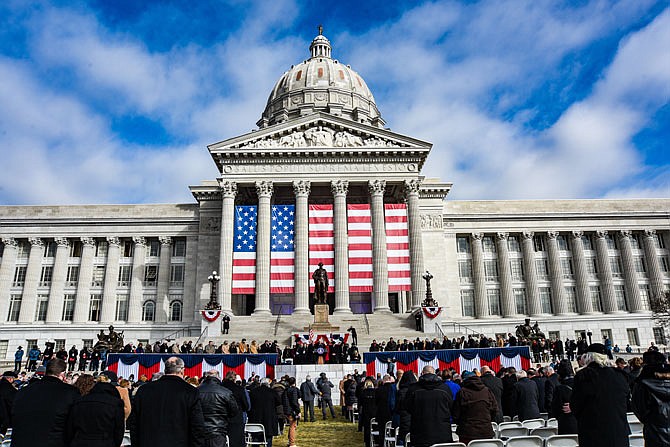The first major construction project on the Missouri state Capitol brought the structure back to serviceable condition while ensuring it is properly preserved for decades to come, according to the state Office of Administration.
The renovation and restoration work on the historic building in Jefferson City was completed last week.
State officials believe they achieved the goal of the project, which was to help preserve and extend the life of the building as well as improve its overall appearance, structural stability and water-shedding capacity.
"It's consistently known as one of the most beautiful state capitol buildings in the nation, so when you live in the Jefferson City area, as I do, it's neat to see it gleaming again," said Dana Rademan Miller, who serves on the Missouri State Capitol Commission charged with the preservation, restoration and renovation of the Capitol and the recording of its history.
The $49.3 million project was part of a bonding project lawmakers approved in 2015. It was separated into two phases.
The first phase of work was done in 2015-16, ending in early December 2017 - in time to hold then-Gov. Eric Greitens' inauguration ceremonies on the Capitol steps in the traditional manner in January 2018.
Phase 1 aimed primarily at waterproofing the Capitol's basement area, including removal of the south and east steps and the east and west sections of the carriage drive, making it easier to install a new waterproofing membrane.
The first phase also included repairs to:
The existing concrete substructure that had deteriorated over the years because of water penetration.
The building terraces, by replacing or repairing damaged stone, concrete support beams and slab, storm drains and joint materials.
The stone work, where mortar and sealant joints had failed and were allowing water to get into interior spaces.
The total cost to complete the first phase of work was $15,136,308, according to OA officials.
During this first phase, they cut open 20 catacombs to repair the concrete structure and repaired more than 1,100 square feet of structural steel, said Mark Hill, division director of Facilities Management Design and Construction.
"Maintaining the Capitol building is a continuous process," Hill said. "We've got additional brass that we've got to do conservation work on and additional plaster repairs inside the building. The process of maintaining a 100-year-old building never stops, but this one main project accomplished work in waterproofing areas that hadn't been waterproofed in 100 years."
Hill said the work in the first phase was critical for the success of the second phase.
The Phase 2 work began in March 2018 and officially wrapped up this past December, in time for inauguration ceremonies in January. The work in this phase included joint replacement and cleaning the entire Capitol.
Some specific areas addressed included:
Renovating and repairing the exterior stone facades on the dome and drum - the area with columns between the dome and the main building.
Facade work, specifically assessing and repairing the stones for cracks and open joints. Some stones that were displaced were reset. All stones were checked to see that they are anchored securely and were cleaned.
Replacing stone and making repairs to the sidewalks and stairs directly off the north drive that lead to the Governor's Portico. State officials said the surface is now more conducive to pedestrian traffic.
Repairing, restoring and waterproofing balustrades.
Removing and/or replacing spotlights and warning lights on the upper dome.
Removing and waterproofing the terrace-level balustrades and repairing or renovating the balustrade lighting.
Replacing joints and generally cleaning the entire Capitol building exterior.
In this phase, more than 4.5 million pounds of stone material was used for repairs and replacement while more than 340,000 square feet of stone was cleaned.
Bronze statue conservation was also completed during this project, with the Ceres statue on top of the Capitol taken down and returned a little more than a year ago. The Thomas Jefferson statue was also repaired, as were the statues representing the Missouri and Mississippi rivers on either side of the south side steps going into the Capitol.
The total cost for this phase of work was $34,225,014.
"This work sealed the envelope of the building to make it safe for those who work here and those who visit," Miller said. "There was a lot of planning and a lot of educating, working proactively to convince people that it was an investment that needed to be made."
Along with the work done on the Capitol itself, the bond money approved by lawmakers five years ago is also paying for other repairs.
In addition to work on the building, restoration of the north plaza took place. That included the Fountain of the Centaurs and the Signing of the Treaty statue directly behind the fountain and the Liberty Bell Memorial. That work was completed in December 2018 for more than $3.1 million.
Just down from the fountain, renovation work at the Veterans Memorial included lighting, plumbing and stone work. It was completed in November 2019 for over $1.3 million.
Structural repairs to the Senate Parking Garage were completed this past November for more than $500,000.
Other bond projects at the Capitol Complex have yet to be completed.
Bidding is taking place to renovate the Senate/House Parking Garage elevator and replace the escalator on the House side. OA officials believe construction will start this fall or summer and may go into fall 2022. They report the cost for this work is more than $1.4 million.
Also being bid is replacing aged HVAC equipment at the Capitol. The reported cost is nearly $4.7 million, and the project would be completed by the end of the year.
By May, OA officials hope to bid work to replace the Capitol's environmental control center, which has a reported cost of just over $8.8 million. The estimated completion date would be April 2022.
There is also repair and replacing of existing skylights being planned with a reported cost of more than $1.5 million. This is currently in the schematic design phase with an estimated construction completion sometime next year.


